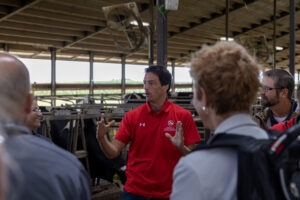Pictured: Francisco Peñagaricano at Arlington Agricultural Research Station. Photo by Nguyen Tran/Dairy Innovation Hub
It’s easy to ruminate over methane when thinking about dairy and its challenges. Dairy cattle are an essential piece of Wisconsin’s $45.6 billion dairy community. But cattle have to eat. And when they eat, they produce the greenhouse gas methane during digestion.
This methane-producing process is natural. Individual cows emit 150 to 260 pounds of the gas per year — primarily in the form of belches. Fortunately, there are ways to reduce the amount of methane that cattle burp up. Scientists from UW-Madison recently received funding from the Greener Cattle Initiative to do exactly that.
The Greener Cattle Initiative, launched by the Foundation for Food & Agriculture Research and the Innovation Center for U.S. Dairy in 2021, is an international multi-partner consortium of stakeholders. It supports research to minimize enteric methane production in dairy cattle.
In September 2023, GCI awarded a $3.3 million grant to Francisco Peñagaricano, UW-Madison assistant professor of animal and dairy sciences. His project is “Integrating genomics, milk spectrometry, and microbial manipulations to mitigate enteric methane emissions from dairy cattle.”
Peñagaricano’s project takes a three-pronged approach to the challenge.
1) using genetics to selectively breed cattle that produce lower methane emissions
2) developing a milk-based test that can predict a cow’s methane emissions
3) exploring the rumen microbiome for possible dietary or other interventions
Peñagaricano is the project’s principal investigator. He’s working with three additional faculty members in the Department of Animal and Dairy Sciences: Hilario Mantovani, who specializes in rumen microbiology; Kent Weigel, who focuses on breeding and genetics; and Heather White, who studies nutritional physiology.
All four UW-Madison team members are in the UW Dairy Innovation Hub. The Hub, funded through a $7.8 million per year investment by the state of Wisconsin, harnesses research and development across the UW-Madison, UW-Platteville, and UW-River Falls campuses to ensure Wisconsin’s $45.6 billion dairy community remains a global pacesetter in dairy innovation.
Through funding awards, including one to Peñagaricano, the Hub has helped purchase two methane-measuring GreenFeed systems. Now the university has five. A GreenFeed device is a portable feeding bin that captures all the air exhaled by a cow while she’s eating. It delivers a reliable estimate of methane emissions for that individual cow.
A first step for the new GCI-funded project will be to develop a reference population of almost 4,000 dairy cows. The first research prong will look at the genetics of these animals. They’ll focus on the natural methane-burping variability found in the group.
All cows produce methane, but not every cow is alike. According to research previously conducted by Peñagaricano, some cows release around 600 grams of methane per day, while others average around 300 grams. For the GCI study, the cows in the reference population will undergo genomic evaluations for various methane emission traits, such as the quantity or frequency of production. Once the team understands these traits, they can pursue selective breeding for cows that produce less methane.
“Variability is crucial, [and] part of that variability is due to genetics,” says Peñagaricano. “We can use that variation to improve cows in the next few generations through genetic selection.”
The second prong of the project explores milk testing. Generally, dairy farmers send monthly milk samples to a lab to monitor quality and to get an idea of protein and fat levels in the milk. Peñagaricano’s team envisions farmers also being able to receive a prediction of methane emissions from the herd. The new test would involve milk spectrometry, scanning milk samples with infrared light to identify specific chemical compounds. The goal is to develop a low-cost, non-invasive tool that farmers could potentially use at the national level.
“Let’s say the federal government or milk buyers say [farmers] need to minimize methane emissions, but first the farmers need to have an idea of which cows are emitting more, and which are emitting less,” says Peñagaricano, “And if they know which ones are emitting more, they can target those cows with interventions, such as specific diets, to minimize that.”
The third prong of the project focuses on the rumen, where methane-producing bacteria are found. Not much is understood about the relationship between the rumen microbiome and methane production, or how cow diet or genetics impact the process. Using emissions data from the GreenFeed systems, the team will identify the 10% highest methane-producing and the 10% lowest methane-producing cows in the reference population and sample their rumen microbiomes. The sampled microbiota will be evaluated for differences, ahead of testing the impact of microbial or dietary interventions.
“Being a part of a project this big is really challenging, but at the same time, really amazing,” says Mantovani, a Hub-funded faculty member who will lead the rumen microbiome studies. “It is an opportunity to have access to a very large number of animals and to do research that could have a real impact in changing management practices and developing new tools.”
Over the course of three years, Peñagaricano, Mantovani, and the rest of the multi-state team will tackle the expansive project and deliver solutions with both short- and long-term benefits for farmers, the broader dairy community, and the environment.
See a previous Mid-West Farm Report story on The Greener Cattle Initiative and the goal to reduce methane from cattle: https://www.midwestfarmreport.com/2023/10/14/researchers-tune-in-to-cow-burps/


